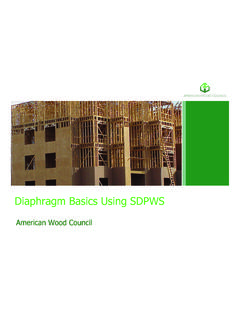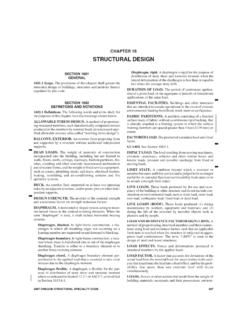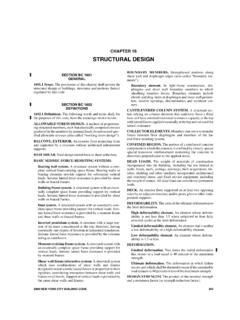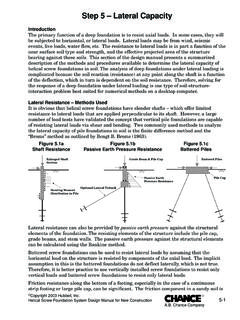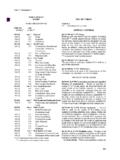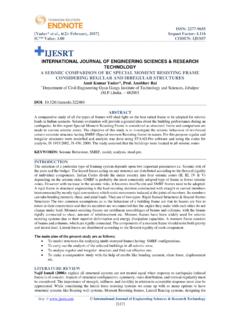Transcription of Full-Scale Load Testing of Steel Strutting System …
1 Report on Full-Scale load Testing of Steel Strutting System For yongnam Holding Limited Prepared by Dr Richard Liew PhD, MIStrutE, CEng, PE(S pore) Department of Civil Engineering National University of Singapore 08 December 2006 (This Report Contains 48 Pages) 1 CONTENTS Page 1 Modular Strutting System 3 2 Test Objectives 3 3 Test setup 4 4 Instrumentation Displacement measurements Stress measurements 5 5 6 5 Test Procedure 7 6 Mechanical Properties of Used Steel 7 7 Test Results Axial load -displacement relationship Applied load - vertical displacement relationship Applied load - lateral displacement relationship Stresses in the main struts Force distribution in the ties and lacing members Test Observations and failure modes 9 9 9 9 10 10 10 8 Comparison with Code s Design Capacity 11 9 Conclusions 12 References 13 Table 1: Loading intervals and observation 14 Table 2: Table 2.
2 Initial out-of-straightness deflection (downwards deflection) of struts before loading 14 Table 3: Locations, alignment and direction of sensors 15 Table 4: Axial load capacity of laced strut -comparison of predicted results with test result 17 Figure 1: Test and instrument layout 18 Figure 2: load application using hydraulic actuators and high-strength strands 19 Figure 3: S Strut with the loading tendons in position 20 Figure 4: Base support allowing horizontal movement 21 Figure 5: Base support preventing lateral translations. 21 Figure 6: Transducer D3 measuring axial displacement at the real end of the strut. 22 Figure 7: Vertical displacement transducers D5 and D6 at the splice joint of strut. 23 Figure 8: Details of coupon specimens and extracted location 24 2 Figure 9: Applied load versus axial displacements 25 Figure 10: Applied load versus vertical deflection 26 Figure 11: Vertical deflection profile of the strut 27 Figure12: load versus lateral displacement at mid-length 27 Figure 13: Stresses on top and bottom flanges of the strut sections at mid-length 28 Figure 14: Axial forces in the Channel Sections 28 Figure 15: Applied load versus axial forces in the lacing members 29 Figure 16: Buckling of the main struts and lacing members after collapse 30 Figure 17: Buckling of the mid-length strut section 31 Figure 18: Another view showing the buckling of the laced strut 32 Figure 19: Applied force versus lacing forces comparison with EC3 approach 33 Appendix A.
3 Certificate of Calibration for Digital Pressure Gauge 34 Appendix B: Coupon Test Results 35 Appendix C: Design Approaches for Calculating Buckling Resistance of Build-up Members 37 BS5950:Part1:2000 Approach BS EN1993-1-1:2005 Approach EC 3 approach to evaluate the shear force of the axially loaded laced struts Example 37 40 46 47 3 Full-Scale load Testing of Steel Strutting System 1 Modular Strutting System yongnam has developed a proprietary Modular System of components that may be assembled to provide a structural Strutting System appropriate for the majority of excavation support requirements. The System comprises of: Laced universal beams of various cross-sections in modular lengths. Single and double waler beams in various lengths, intermediate supporting beams, king posts, bracing and waler support brackets.
4 Various strut to waler joints have been produced to suit to suit the site conditions as required. The yongnam Strutting System has been used in many basement construction and civil engineering excavation works including high-rise and mass rapid transit projects in Singapore, Hong Kong and the Middle East. There are, however, a number of questions asked with regard to the performance of the modular Strutting System , such as the performance of the splice joint, strength of the reusable materials, force distributions in the lacings and channels between the main struts. In response to these questions, a full scale load test of used modular Strutting System spanning about 20m was carried out in the premise of yongnam Holdings Limited, located at 51 Tuas South Street 5, Singapore 637644, on 8 November 2006.
5 This report provides the test results and their interpretation with regard to the performance of the Strutting System in comparison with the code s predicted results. 2 Test Objectives The objectives of carrying out full scale test on the laced strut System are: To determine the maximum load capacity of the strut System and compare against the design capacity To investigate the performance and to identify the possible failure mode of the strut System To ascertain the maximum induced forces on lacing members and compare them with results predicted by the design equations given in BS5950:2000:Part 1 and Eurocode 3 To investigate the force distributions on the lacing members along the length of the strut 4 To study the load -displacement behaviour of the strut System To determine the strength of re-usable strut materials and their implication to structural safety.
6 To accomplish the objectives, the Strutting System was load tested to failure to establish its buckling capacity and failure mode. The failure load is compared with the code s predicted load to gain insight to its ultimate strength behaviour. The load -displacement relationship and internal force distribution in the main struts and lacing members were monitored on-line during the test. 3 Test Setup The test specimen consists of two universal beams, UB 610x324x195 kg/m, inter-connected by diagonal laces of equal angle section , and ties of channel sections C254x76 and C254x90 as shown in Figure 1. The length of the strut is consisting of three modular segments of lengths , 12m and The three strut segments were connected by using 8 number of M24 Grade bolts via flush end plate connections.
7 The two end-strut segments was about 4 years old and they were used in KPE Strutting works for project C-421 and circle line MRT project C-853. The central strut segment of 12m length was more than 6 years old and had been used in Hong Kong MRT project and subsequently deployed to LTA projects C-421 and C-851 (Note: This information was provided by yongnam Holdings on requested by the author). The laced strut specimen was arranged in a horizontal position and connected to waler beams at both ends. Loads were applied horizontally from the ends of the struts through the waler beams using three hydraulic jacks of maximum capacity of 800 tons each (Figure 2). The loading System utilizes high tensile strands running along the sides of the strut and mounted onto the walers at the ends applying a compressive loading on the struts (see Figure 3).
8 A third party contractor, VSL Singapore Pte Ltd, was engaged to supply and operate the hydraulic jacks. The jacks are linked to share equal hydraulic pressure during load application using a hydraulic pump. Each hydraulic jack was connected to 31 numbers of " diameter super low relaxation strands with the following properties: Nominal Diameter of the strand: Nominal Area: 150mm Yield Strength: 1500 MPa Min. Breaking load : 265 kN 5 The load was controlled by using a digital pressure gauge which was calibrated to ISO 17025. The certificate of calibration is attached in Appendix A. Total applied load was manually communicated to the data acquisition System at predetermined loading intervals listed in Table 1. The two ends of the Strutting System were bolted to waler beams which were supported by short columns.
9 The column bases were welded to end-plates. One end of the column base was seated on a smooth concrete pad allowing free translation in the longitudinal direction of the strut as shown in Figure 4. The other end of the column base (where the hydraulic jacks were mounted) was bolted down to the concrete pad preventing any lateral movement (see Figure 5). The bolt connection to the concrete pad offered very little resisting against overturning moment. The two end boundary conditions of the Strutting System simulate a pinned support and a roller support condition. Before loading, the initial vertical deflection of the struts was measured and the results are shown in Table 2. The strut has initial out-of-straightness with maximum vertical deflection of about 19 mm at the spliced joint.
10 This is slightly less than the maximum out-of-straightness tolerance of span length/1000 (or ) for column design as in BS5950:Part1:2000 [Ref. 1]. The initial out-of-straightness in the lateral direction of the strut was found to be very small. This was due to the present of lateral bracing members which controlled the straightness of the two struts in the lateral direction. 4 Instrumentation The test specimen was instrumented with strain gauges and displacement transducers to determine the stresses in the strut and the lacing members and the lateral and vertical displacements. The instrumentation layout plan is shown in Figure 1. A summary of the sensor locations and their sensing direction is given in Table 3.
